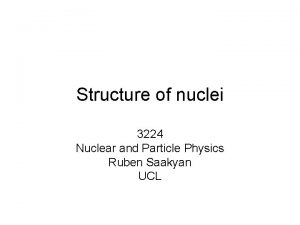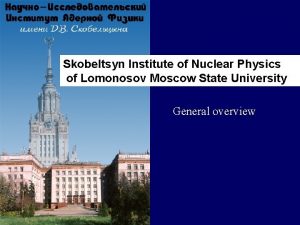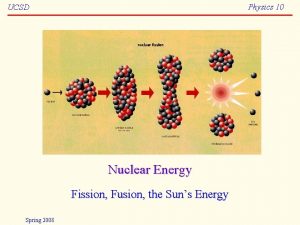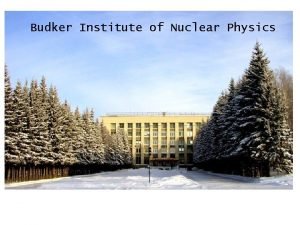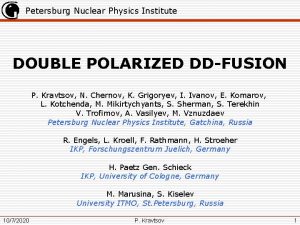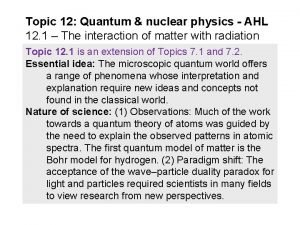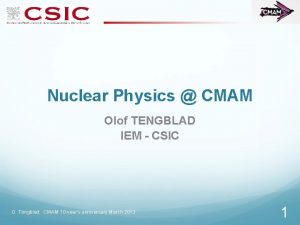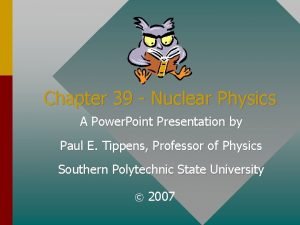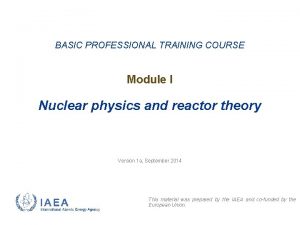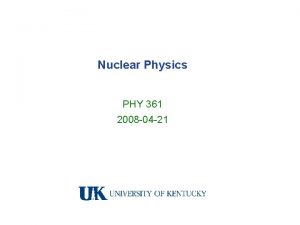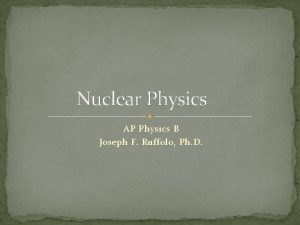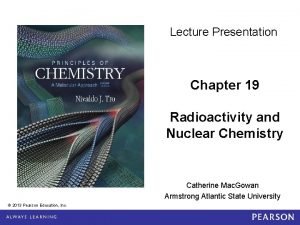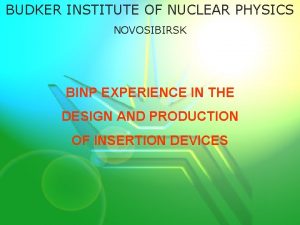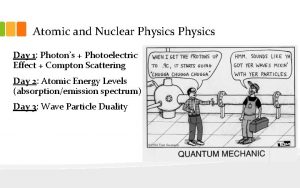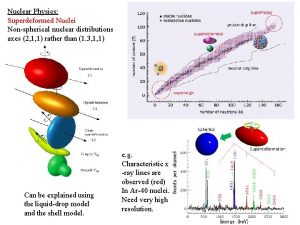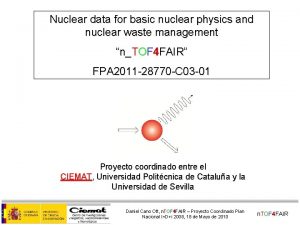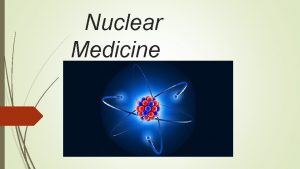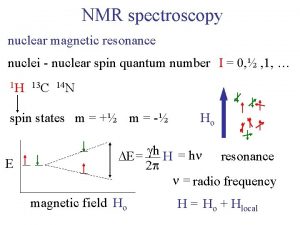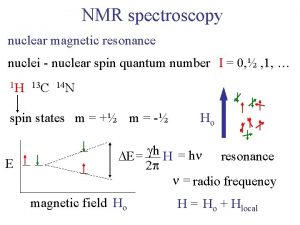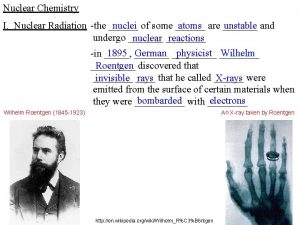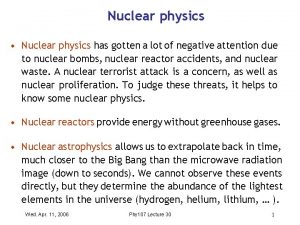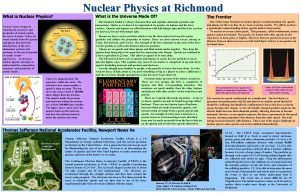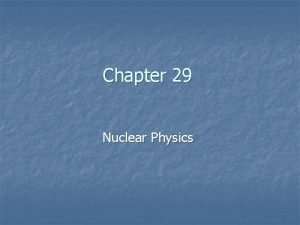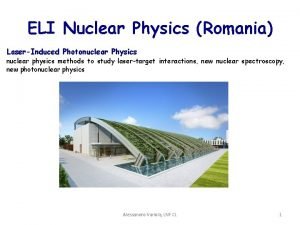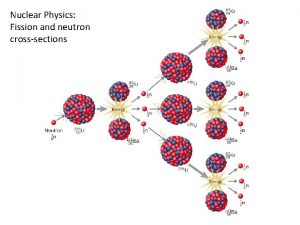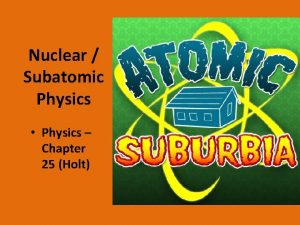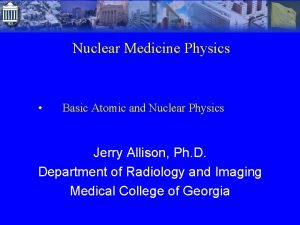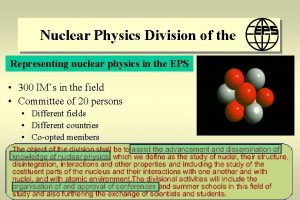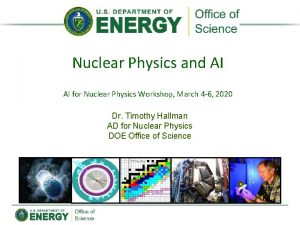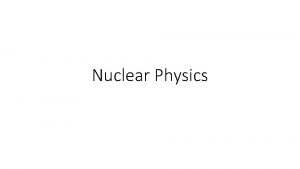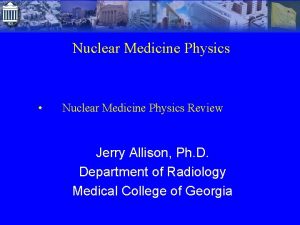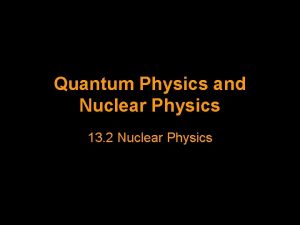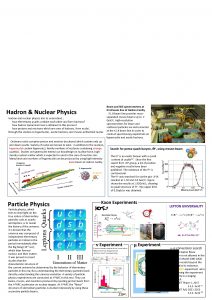The Physics of Nuclei II Nuclear Structure Ian



















































- Slides: 51

The Physics of Nuclei II: Nuclear Structure Ian Thompson Nuclear Theory & Modelling Group Lawrence Livermore National Laboratory. University of California, Lawrence Livermore National Laboratory UCRL-PRES-232487 NNPSS: July 9 -11, 2007 University of California, Lawrence Livermore National Laboratory under contract No. W-7405 -Eng-48. This work was supported in part from LDRD contract 00 -ERD -028 1

Structure Synopsis • Heavier Nuclei, so: • Simpler Structure Theories: – Liquid-Drop model – Magic Numbers at Shells; Deformation; Pairing – Shell Model – Hartree-Fock (Mean-field; Energy Density Functional) NNPSS: July 9 -11, 2007 2

Segré Chart of Isotopes NNPSS: July 9 -11, 2007 3

Segré Chart of Isotopes NNPSS: July 9 -11, 2007 4

Nuclei with A≥ 16 • Start with Liquid-Drop model – Parametrise binding energies – Look for improvements • Magic Numbers for Shells • Shell Corrections • Deformation • Pairing • Shell Model • Mean field: Hartree-Fock NNPSS: July 9 -11, 2007 5

Nuclear masses: what nuclei exist? • One goal in theory is to accurately describe the binding energy Let’s start with the semi-empirical mass formula, Bethe-Weizsäcker formual, or also the liquid-drop model. – There are global Volume, Surface, Symmetry, and Coulomb terms – And specific corrections for each nucleus due to pairing and shell structure Values for the parameters, A. H. Wapstra and N. B. Gove, Nulc. Data Tables 9, 267 (1971) NNPSS: July 9 -11, 2007 6

Nuclear masses, what nuclei exist? Liquid-drop isn’t too bad! There are notable problems though. Can we do better and what about the microscopic structure? From A. Bohr and B. R. Mottleson, Nuclear Structure, vol. 1, p. 168 Benjamin, 1969, New York Bethe-Weizsäcker formula NNPSS: July 9 -11, 2007 7

Nuclear masses, what nuclei exist? • • How about deformation? For each energy term, there also shape factors dependent on the quadrupole deformation parameters b and g Note that the liquid drop always has a minimum for a spherical shape! So, where does deformation come from? NNPSS: July 9 -11, 2007 8

Shell structure - evidence in atoms • Atomic ionization potentials show sharp discontinuities at shell boundaries From A. Bohr and B. R. Mottleson, Nuclear Structure, vol. 1, p. 191 Benjamin, 1969, New York NNPSS: July 9 -11, 2007 9

Shell structure - neutron separation energies • So do neutron separation energies From A. Bohr and B. R. Mottleson, Nuclear Structure, vol. 1, p. 193 Benjamin, 1969, New York NNPSS: July 9 -11, 2007 10

More evidence of shell structure Binding energies show preferred magic numbers – 2, 8, 20, 28, 50, 82, and 126 Deviation from average binding energy Experimental Single-particle Effect (Me. V) • From W. D. Myers and W. J. Swiatecki, Nucl. Phys. 81, 1 (1966) NNPSS: July 9 -11, 2007 11

Origin of the shell model • Goeppert-Mayer and Haxel, Jensen, and Suess proposed the independent-particle shell model to explain the magic numbers 168 112 Harmonic oscillator with spin-orbit is a reasonable approximation to the nuclear mean field 70 40 20 8 2 M. G. Mayer and J. H. D. Jensen, Elementary Theory of Nuclear Shell Structure, p. 58, Wiley, New York, 1955 NNPSS: July 9 -11, 2007 12

Nilsson Hamiltonian - Poor man’s Hartree-Fock • Anisotropic harmonic oscillator From J. M. Eisenberg and W. Greiner, Nuclear Models, p 542, North Holland, Amsterdam, 1987 Oblate, g=60˚ Prolate, g=0˚ NNPSS: July 9 -11, 2007 13

Nuclear masses Shell corrections to the liquid drop • Shell correction – In general, the liquid drop does a good job on the bulk properties • The oscillator doesn’t! – But we need to put in corrections due to shell structure • Strutinsky averaging; difference between the energy of the discrete spectrum and the averaged, smoothed spectrum Discrete spectrum Mean-field single-particle spectrum NNPSS: July 9 -11, 2007 Smoothed spectrum 14

Nilsson-Strutinsky and deformation • Energy surfaces as a function of deformation From C. G. Andersson, et al. , Nucl. Phys. A 268, 205 (1976) Nilsson-Strutinsky is a mean-field type approach that allows for a comprehensive study of nuclear deformation under rotation and at high temperature NNPSS: July 9 -11, 2007 15

Nuclear masses Pairing corrections to the liquid drop • Pairing: From A. Bohr and B. R. Mottleson, Nuclear Structure, vol. 1, p. 170 Benjamin, 1969, New York NNPSS: July 9 -11, 2007 16

The Shell Model • More microscopic theory – Include all nucleons – Fully antisymmetrised wave functions – Include all correlations in a ‘shell’. – Harmonic Oscillator basis states. • Effective Hamiltonian – Still needed! – Find or fit potential matrix elements, NNPSS: July 9 -11, 2007 17

Many-body Hamiltonian • Start with the many-body Hamiltonian • Introduce a mean-field U to yield basis 0 f 1 p N=4 0 d 1 s N=2 1 p N=1 0 s N=0 Residual interaction • • The mean field determines the shell structure In effect, nuclear-structure calculations rely on perturbation theory The success of any nuclear structure calculation depends on the choice of the mean-field basis and the residual interaction! NNPSS: July 9 -11, 2007 18

Single-particle wave functions • • With the mean-field, we have the basis for building many-body states This starts with the single-particle, radial wave functions, defined by the radial quantum number n, orbital angular momentum l, and z-projection m – Now include the spin wave function: • Two choices, jj-coupling or ls-coupling – Ls-coupling – jj-coupling is very convenient when we have a spin-orbit (l s) force NNPSS: July 9 -11, 2007 19

Multiple-particle wave functions • • Total angular momentum, and isospin; Anti-symmetrized, two particle, jj-coupled wave function – Note J+T=odd if the particles occupy the same orbits • Anti-symmetrized, two particle, LS-coupled wave function NNPSS: July 9 -11, 2007 20

Two-particle wave functions • Of course, the two pictures describe the same physics, so there is a way to connect them – Recoupling coefficients • Note that the wave functions have been defined in terms of often we need them in terms of the relative coordinate and , but – We can do this in two ways • Transform the operator Quadrupole, l=2, component is large and very important NNPSS: July 9 -11, 2007 21

Two-particle wave functions in relative coordinate • Use Harmonic-oscillator wave functions and decompose in terms of the relative and center-of-mass coordinates, i. e. , • Harmonic oscillator wave functions are a very good approximation to the single-particle wave functions We have the useful transformation • – – 2 n 1+l 2+2 n 2+l 2=2 n+l+2 N+L Where the M(nl. NL; n 1 l 1 n 2 l 2) is known as the Moshinksy bracket Note this is where we use the jj to LS coupling transformation For some detailed applications look in Theory of the Nuclear Shell Model, R. D. Lawson, (Clarendon Press, Oxford, 1980) NNPSS: July 9 -11, 2007 22

Many-particle wave function • • To add more particles, we just continue along the same lines To build states with good angular momentum, we can bootstrap up from the two-particle case, being careful to denote the distinct states – This method uses Coefficients of Fractional Parentage (CFP) • Or we can make a many-body Slater determinant that has only a specified Jz and Tz and project J and T In general Slater determinants are more convenient NNPSS: July 9 -11, 2007 23

Second Quantization • • Second quantization is one of the most useful representations in many-body theory Creation and annihilation operators – – • Denote |0 as the state with no particles (the vacuum) ai+ creates a particle in state i; ai annihilates a particle in state i; Anti-commutation relations: Many-body Slater determinant NNPSS: July 9 -11, 2007 24

Second Quantization • Operators in second-quantization formalism – Take any one-body operator O, say quadrupole E 2 transition operator er 2 Y 2 m, the operator is represented as: where j|O|i is the single-particle matrix element of the operator O – The same formalism exists for any n-body operator, e. g. , for the NNinteraction • Here, I’ve written the two-body matrix element with an implicit assumption that it is anti-symmetrized, i. e. , NNPSS: July 9 -11, 2007 25

Second Quantization • Matrix elements for Slater determinants (all aceklm different) Second quantization makes the computation of expectation values for the many-body system simpler NNPSS: July 9 -11, 2007 26

Second Quantization • Angular momentum tensors – Creation operators rotate as tensors of rank j – Not so for annihilation operators • Anti-symmetrized, two-body state NNPSS: July 9 -11, 2007 27

Shell-model mean field • One place to start for the mean field is the harmonic oscillator – Specifically, we add the center-of-mass potential – The Good: • Provides a convenient basis to build the many-body Slater determinants • Does not affect the intrinsic motion • Exact separation between intrinsic and center-of-mass motion – The Bad: • Radial behavior is not right for large r • Provides a confining potential, so all states are effectively bound NNPSS: July 9 -11, 2007 28

Low-lying structure – The interacting Shell Model • • The interacting shell model is one of the most powerful tools available too us to describe the low-lying structure of light nuclei We start at the usual place: 0 f 1 p N=4 0 d 1 s N=2 • Construct many-body states |fi so that 1 p N=1 0 s N=0 • Calculate Hamiltonian matrix Hij= fj|H|fi – Diagonalize to obtain eigenvalues We want an accurate description of low-lying states NNPSS: July 9 -11, 2007 29

Shell model applications • The practical Shell Model 1. Choose a model space to be used for a range of nuclei • E. g. , the 0 d and 1 s orbits (sd-shell) for 16 O to 40 Ca or the 0 f and 1 p orbits for 40 Ca to 120 Nd 2. 3. 4. 5. We start from the premise that the effective interaction exists We use effective interaction theory to make a first approximation (G-matrix) Then tune specific matrix elements to reproduce known experimental levels With this empirical interaction, then extrapolate to all nuclei within the chosen model space 6. Note that radial wave functions are explicitly not included, so we add them in later The empirical shell model works well! But be careful to know the limitations! NNPSS: July 9 -11, 2007 30

Simple application of the shell model • A=18, two-particle problem with 16 O core – Two protons: 18 Ne (T=1) – One Proton and one neutron: 18 F (T=0 and T=1) – Two neutrons: 18 O (T=1) Example: 18 O Question # 1? • How many states for each Jz? How many states of each J? – There are 14 states with Jz=0 • • • N(J=0)=3 N(J=1)=2 N(J=2)=5 N(J=3)=2 N(J=4)=2 NNPSS: July 9 -11, 2007 31

Simple application of the shell model, cont. Example: Question #2 • What are the energies of the three 0+ states in 18 O? – Use the Universal SD-shell interaction (Wildenthal) Measured relative to 16 O core Note 0 d 3/2 is unbound NNPSS: July 9 -11, 2007 32

Simple application of the shell model, cont. Example: Finding the eigenvalues • 3. 522 1. 964 -0. 830 -1. 243 -1. 348 -1. 616 -2. 706 -3. 421 11. 341 10. 928 10. 823 10. 555 9. 465 8. 750 2+ -6. 445 -7. 732 -7. 851 -8. 389 -9. 991 5. 726 4. 440 4. 320 3. 781 2. 180 0+ -12. 171 0. 000 Set up the Hamiltonian matrix – We can use all 14 Jz=0 states, and we’ll recover all 14 J-states – But for this example, we’ll use the two-particle J=0 states |(0 d 5/2)2 J=0 |(1 s 1/2)2 J=0 1+ |(0 d 3/2)2 J=0 3+ 4+ NNPSS: July 9 -11, 2007 33

What about heavier nuclei? • Above A ~ 60 or so the number of configurations just gets to be too large ~ 1010! • Here, we need to think of more approximate methods • The easiest place to start is the mean-field of Hartree-Fock – But, once again we have the problem of the interaction • Repulsive core causes us no end of grief!! • So still need effective interactions! • At some point use fitted effective interactions like the Skyrme force NNPSS: July 9 -11, 2007 34

Hartree-Fock • • There are many choices for the mean field, and Hartree-Fock is one optimal choice We want to find the best single Slater determinant F 0 so that • Thouless’ theorem – Any other Slater determinant F not orthogonal to F 0 may be written as – Where i is a state occupied in F 0 and m is unoccupied – Then NNPSS: July 9 -11, 2007 35

Hartree-Fock • • Let i, j, k, l denote occupied states and m, n, o, p unoccupied states After substituting back we get • This leads directly to the Hartree-Fock single-particle Hamiltonian h with matrix elements between any two states a and b NNPSS: July 9 -11, 2007 36

Hartree-Fock • We now have a mechanism for defining a mean-field – It does depend on the occupied states – Also the matrix elements with unoccupied states are zero, so the first order 1 p-1 h corrections do not contribute • We obtain an eigenvalue equation (more on this later) • Energies of A+1 and A-1 nuclei relative to A NNPSS: July 9 -11, 2007 37

Hartree-Fock – Eigenvalue equation • Two ways to approach the eigenvalue problem – Coordinate space where we solve a Schrödinger-like equation – Expand in terms of a basis, e. g. , harmonic-oscillator wave function • Expansion – Denote basis states by Greek letters, e. g. , a – From the variational principle, we obtain the eigenvalue equation NNPSS: July 9 -11, 2007 38

Hartree-Fock – Solving the eigenvalue equation • • As I have written the eigenvalue equation, it doesn’t look to useful because we need to know what states are occupied We use three steps 1. Make an initial guess of the occupied states & the expansion coefficients Cia • For example the lowest Harmonic-oscillator states, or a Woods-Saxon and Cia=dia 2. With this ansatz, set up the eigenvalue equations and solve them 3. Use the eigenstates |i from step 2 to make the Slater determinant F 0, go back to step 2 until the coefficients Cia are unchanged The Hartree-Fock equations are solved self-consistently NNPSS: July 9 -11, 2007 39

Hartree-Fock – Coordinate space • Here, we denote the single-particle wave functions as fi(r) Direct or Hartree term: UH • Exchange or Fock term: UF These equations are solved the same way as the matrix eigenvalue problem before 1. Make a guess for the wave functions fi(r) and Slater determinant F 0 2. Solve the Hartree-Fock differential equation to obtain new states fi(r) 3. With these go back to step 2 and repeat until fi(r) are unchanged Again the Hartree-Fock equations are solved self-consistently NNPSS: July 9 -11, 2007 40

Hartree-Fock Hard homework problem: • • M. Moshinsky, Am. J. Phys. 36, 52 (1968). Erratum, Am. J. Phys. 36, 763 (1968). Two identical spin-1/2 particles in a spin singlet interact via the Hamiltonian • Use the coordinates energy and wave function are • Note that since the spin wave function (S=0) is anti-symmetric, the spatial wave function is symmetric and NNPSS: July 9 -11, 2007 to show the exact 41

Hartree-Fock Hard homework problem: • The Hartree-Fock solution for the spatial part is the same as the Hartree solution for the S-state. Show the Hartree energy and radial wave function are: 20 E/h 15 10 Eexact EH 5 0 0 5 10 15 c 20 25 30 NNPSS: July 9 -11, 2007 42

Hartree-Fock with the Skyrme interaction • • In general, there are serious problems trying to apply Hartree-Fock with realistic NN-interactions (for one the saturation of nuclear matter is incorrect) Use an effective interaction, in particular a force proposed by Skyrme – Ps is the spin-exchange operator • The three-nucleon interaction is actually a density dependent two-body, so replace with a more general form, where a determines the incompressibility of nuclear matter NNPSS: July 9 -11, 2007 43

Hartree-Fock with the Skyrme interaction • • One of the first references: D. Vautherin and D. M. Brink, PRC 5, 626 (1972) Solve a Schrödinger-like equation tz labels protons or neutrons – Note the effective mass m* – Typically, m* < m, although it doesn’t have to, and is determined by the parameters t 1 and t 2 • • The effective mass influences the spacing of the single-particle states The bias in the past was for m*/m ~ 0. 7 because of earlier calculations with realistic interactions NNPSS: July 9 -11, 2007 44

Hartree-Fock calculations • The nice thing about the Skyrme interaction is that it leads to a computationally tractable problem – Spherical (one-dimension) – Deformed • • • Axial symmetry (two-dimensions) No symmetries (full three-dimensional) There also many different choices for the Skyrme parameters – They all do some things right, and some things wrong, and to a large degree it depends on what you want to do with them – Some of the leading (or modern) choices are: • • M*, M. Bartel et al. , NPA 386, 79 (1982) Sk. P [includes pairing], J. Dobaczewski and H. Flocard, NPA 422, 103 (1984) Sk. X, B. A. Brown, W. A. Richter, and R. Lindsay, PLB 483, 49 (2000) Apologies to those not mentioned! – There is also a finite-range potential based on Gaussians due to D. Gogny, D 1 S, J. Dechargé and D. Gogny, PRC 21, 1568 (1980). • Take a look at J. Dobaczewski et al. , PRC 53, 2809 (1996) for a nice study near the neutron drip-line and the effects of unbound states NNPSS: July 9 -11, 2007 45

Nuclear structure • Remember what our goal is: – To obtain a quantitative description of all nuclei within a microscopic frame work – Namely, to solve the many-body Hamiltonian: Residual interaction Perturbation Theory NNPSS: July 9 -11, 2007 46

Nuclear structure • Hartree-Fock is the optimal choice for the mean-field potential U(r)! – The Skyrme interaction is an “effective” interaction that permits a wide range of studies, e. g. , masses, halo-nuclei, etc. – Traditionally the Skyrme parameters are fitted to binding energies of doubly magic nuclei, rms charge-radii, the incompressibility, and a few spin-orbit splittings • One goal would be to calculate masses for all nuclei – By fixing the Skyrme force to known nuclei, maybe we can get 500 ke. V accuracy that CAN be extrapolated into the unknown region • This will require some input about neutron densities – parity-violating electron scattering can determine <r 2>p-<r 2>n. – This could have an important impact NNPSS: July 9 -11, 2007 47

Hartree-Fock calculations • Permits a study of a wide-range of nuclei, in particular, those far from stability and with exotic properties, halo nuclei H. Sagawa, PRC 65, 064314 (2002) The tail of the radial density depends on the separation energy S. Mizutori et al. PRC 61, 044326 (2000) NNPSS: July 9 -11, 2007 Drip-line studies J. Dobaczewski et al. , PRC 53, 2809 (1996) 48

What can Hartree-Fock calculations tell us about shell structure? • Shell structure – Because of the self-consistency, the shell structure can change from nucleus to nucleus As we add neutrons, traditional shell closures are changed, and may even disappear! This is THE challenge in trying to predict the structure of nuclei at the drip lines! J. Dobaczewski et al. , PRC 53, 2809 (1996) NNPSS: July 9 -11, 2007 49

Beyond mean field • Hartee-Fock is a good starting approximation – There are no particle-hole corrections to the HF ground state – The first correction is • However, this doesn’t make a lot of sense for Skyrme potentials – They are fit to closed-shell nuclei, so they effectively have all these higherorder corrections in them! • We can try to estimate the excitation spectrum of one-particle-one-hole states – Giant resonances – Tamm-Dancoff approximation (TDA) – Random-Phase approximation (RPA) NNPSS: July 9 -11, 2007 You should look these up! A Shell Model Description of Light Nuclei, I. S. Towner The Nuclear Many-Body Problem, Ring & Schuck 50

Nuclear structure in the future Monte Carlo Shell Model ck e rtr a , H d l e o e-F -fi an Me Standard shell model Ab initio methods With newer methods and powerful computers, the future of nuclear structure theory is bright! NNPSS: July 9 -11, 2007 51
 Lesson 15 nuclear quest nuclear reactions
Lesson 15 nuclear quest nuclear reactions Fisión nuclear vs fision nuclear
Fisión nuclear vs fision nuclear Quantum and nuclear physics
Quantum and nuclear physics Magic number in nuclear physics
Magic number in nuclear physics Skobeltsyn institute of nuclear physics
Skobeltsyn institute of nuclear physics Nuclear energy in physics
Nuclear energy in physics Scattering cross section in nuclear physics
Scattering cross section in nuclear physics Budker institute of nuclear physics
Budker institute of nuclear physics Petersburg nuclear physics institute
Petersburg nuclear physics institute Physics topic 12
Physics topic 12 Nuclear physics
Nuclear physics Nuclear physics topics for presentation
Nuclear physics topics for presentation Nuclear physics
Nuclear physics Nuclear physics
Nuclear physics Nuclear physics
Nuclear physics Nuclear physics b
Nuclear physics b Magic number
Magic number Nuclear physics
Nuclear physics Budker institute of nuclear physics
Budker institute of nuclear physics Nuclear physics day
Nuclear physics day Modern physics vs classical physics
Modern physics vs classical physics University physics with modern physics fifteenth edition
University physics with modern physics fifteenth edition Ib physics ia example
Ib physics ia example Hát kết hợp bộ gõ cơ thể
Hát kết hợp bộ gõ cơ thể Lp html
Lp html Bổ thể
Bổ thể Tỉ lệ cơ thể trẻ em
Tỉ lệ cơ thể trẻ em Chó sói
Chó sói Tư thế worms-breton
Tư thế worms-breton Alleluia hat len nguoi oi
Alleluia hat len nguoi oi Các môn thể thao bắt đầu bằng tiếng nhảy
Các môn thể thao bắt đầu bằng tiếng nhảy Thế nào là hệ số cao nhất
Thế nào là hệ số cao nhất Các châu lục và đại dương trên thế giới
Các châu lục và đại dương trên thế giới Công thức tính thế năng
Công thức tính thế năng Trời xanh đây là của chúng ta thể thơ
Trời xanh đây là của chúng ta thể thơ Cách giải mật thư tọa độ
Cách giải mật thư tọa độ 101012 bằng
101012 bằng Phản ứng thế ankan
Phản ứng thế ankan Các châu lục và đại dương trên thế giới
Các châu lục và đại dương trên thế giới Thể thơ truyền thống
Thể thơ truyền thống Quá trình desamine hóa có thể tạo ra
Quá trình desamine hóa có thể tạo ra Một số thể thơ truyền thống
Một số thể thơ truyền thống Cái miệng bé xinh thế chỉ nói điều hay thôi
Cái miệng bé xinh thế chỉ nói điều hay thôi Vẽ hình chiếu vuông góc của vật thể sau
Vẽ hình chiếu vuông góc của vật thể sau Thế nào là sự mỏi cơ
Thế nào là sự mỏi cơ đặc điểm cơ thể của người tối cổ
đặc điểm cơ thể của người tối cổ V. c c
V. c c Vẽ hình chiếu đứng bằng cạnh của vật thể
Vẽ hình chiếu đứng bằng cạnh của vật thể Fecboak
Fecboak Thẻ vin
Thẻ vin đại từ thay thế
đại từ thay thế điện thế nghỉ
điện thế nghỉ



